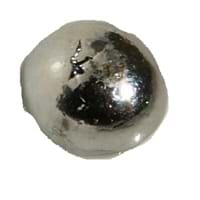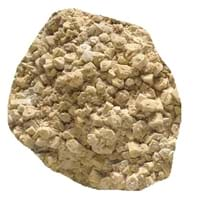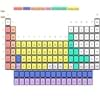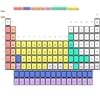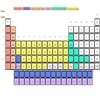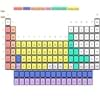Rhenium Strontium Comparison
Periodic Table
Symbol
Re
Sr
Group Number
7
11
2
16
Period Number
6
5
Block
d block
s block
Element Family
Transition Metal
Alkaline Earth
CAS Number
7440155
99+
7440246
99+
Space Group Name
P63/mmc
Fm_ 3m
Space Group Number
194.00
5
225.00
2
Facts
Interesting Facts
- Chemical properties of Rhenium are similar to Manganese.
- Rhenium metal is created while refining Molybdenum.
- Strontium element is softer than Calcium.
- Silvery Strontium turns yellow, if exposed to air.
Sources
Found in Minerals, Mining, Ores of Minerals
Found in Minerals, Mining, Ores of Minerals
History
Who Discovered
Masataka Ogawa
William Cruickshank
Discovery
In 1908
In 1787
Abundance
Abundance In Universe
2 * 10-8 %
29
4 * 10-6 %
14
Abundance In Sun
~0.00000001 %
29
~0.000005 %
15
Abundance In Meteorites
0.00 %
99+
0.00 %
15
Abundance In Earth's Crust
0.00 %
99+
0.04 %
10
Abundance In Oceans
0.00 %
34
0.00 %
4
Abundance In Humans
Not Available
0.00 %
7
Uses
Uses & Benefits
- Alloys of Rhenium are used as an electric contact material. It can resist withstand arc corrosion.
- Its catalysts are used in hydrogenation of fine chemicals. Its Alloy with nickel is used to produce turbine blades.
- Strontium metal is used to producing ferrite magnets as well as refining zinc.
- By-product of nuclear reactors called Strontium-90 is a radioactive isotope; it is absorbed by tissues and destroys bone marrow and cancer growth.
Industrial Uses
Aerospace Industry, Automobile Industry, Chemical Industry, Electrical Industry, Electronic Industry
Ammunition Industry, Chemical Industry
Medical Uses
NA
NA
Other Uses
Alloys
Alloys
Biological Properties
Toxicity
Low Toxic
Non Toxic
Present in Human Body
No
Yes
In Blood
Not Available
0.03 Blood/mg dm-3
19
In Bone
Not Available
140.00 p.p.m.
7
Physical Properties
Melting Point
3,180.00 °C
2
769.00 °C
99+
Boiling Point
5,627.00 °C
2
1,384.00 °C
99+
Appearance
Physical State
Solid
Solid
Color
Silvery Gray
Silvery White
Luster
Metallic
Metallic
Hardness
Mohs Hardness
7.00
3
1.50
18
Brinell Hardness
1,320.00 MPa
8
Not Available
Vickers Hardness
1,350.00 MPa
7
Not Available
Speed of Sound
4,700.00 m/s
15
Not Available
Optical Properties
Allotropes
No
No
α Allotropes
Not Available
Not Available
β Allotropes
Not Available
Not Available
γ Allotropes
Not Available
Not Available
Chemical Properties
Chemical Formula
Re
Sr
Isotopes
Known Isotopes
33
6
27
12
Electronegativity
Pauling Electronegativity
1.90
11
0.95
99+
Sanderson Electronegativity
Not Available
0.72
27
Allred Rochow Electronegativity
1.46
15
0.99
37
Mulliken-Jaffe Electronegativity
Not Available
1.00
18
Allen Electronegativity
1.60
21
0.96
40
Electropositivity
Pauling Electropositivity
2.10
99+
3.05
7
Ionization Energies
1st Energy Level
760.00 kJ/mol
20
549.50 kJ/mol
99+
2nd Energy Level
1,260.00 kJ/mol
99+
1,064.20 kJ/mol
99+
3rd Energy Level
2,510.00 kJ/mol
99+
4,138.00 kJ/mol
10
4th Energy Level
3,640.00 kJ/mol
99+
5,500.00 kJ/mol
13
5th Energy Level
Not Available
6,910.00 kJ/mol
18
6th Energy Level
Not Available
8,760.00 kJ/mol
18
7th Energy level
Not Available
10,230.00 kJ/mol
19
8th Energy Level
Not Available
11,800.00 kJ/mol
19
9th Energy Level
Not Available
15,600.00 kJ/mol
17
10th Energy Level
Not Available
17,100.00 kJ/mol
19
11th Energy Level
Not Available
31,270.00 kJ/mol
6
Electrochemical Equivalent
0.99 g/amp-hr
99+
1.64 g/amp-hr
99+
Electron Work Function
4.96 eV
7
2.59 eV
99+
Other Chemical Properties
Corrosion, Ionization, Radioactive Isotopes, Solubility
Ionization, Radioactive Isotopes, Radioactivity, Solubility
Atomic Properties
Atomic Number
75
99+
38
99+
Electron Configuration
[Xe] 4f14 5d5 6s2
[Kr] 5s2
Crystal Structure
Hexagonal Close Packed (HCP)
Face Centered Cubic (FCC)
Crystal Lattice
BCC-Crystal-Structure-.jpg#100
FCC-Crystal-Structure-of-Strontium.jpg#100
Atom
Number of Protons
75
40
38
99+
Number of Neutrons
111
26
50
99+
Number of Electrons
75
40
38
99+
Radius of an Atom
Atomic Radius
137.00 pm
40
215.00 pm
5
Covalent Radius
151.00 pm
34
195.00 pm
15
Van der Waals Radius
200.00 pm
28
249.00 pm
7
Atomic Weight
186.21 amu
36
87.62 amu
99+
Atomic Volume
8.85 cm3/mol
99+
33.70 cm3/mol
6
Adjacent Atomic Numbers
Valence Electron Potential
180.00 (-eV)
3
25.70 (-eV)
99+
Lattice Constant
276.10 pm
99+
608.49 pm
6
Lattice Angles
π/2, π/2, 2 π/3
π/2, π/2, π/2
Lattice C/A Ratio
1.62
3
Not Available
Mechanical Properties
Density
Density At Room Temperature
21.02 g/cm3
12
2.64 g/cm3
99+
Density When Liquid (at m.p.)
18.90 g/cm3
4
2.38 g/cm3
99+
Tensile Strength
1,070.00 MPa
3
Not Available
Viscosity
Not Available
Not Available
Vapor Pressure
Vapor Pressure at 1000 K
Not Available
121.00 (Pa)
1
Vapor Pressure at 2000 K
0.00 (Pa)
29
Not Available
Elasticity properties
Shear Modulus
178.00 GPa
3
6.03 GPa
99+
Bulk Modulus
370.00 GPa
2
Not Available
Young's Modulus
463.00 GPa
2
15.70 GPa
99+
Poisson Ratio
0.30
14
0.28
17
Other Mechanical Properties
Ductile, Malleable
NA
Magnetic Properties
Magnetic Characteristics
Specific Gravity
21.02
5
2.64
99+
Magnetic Ordering
Paramagnetic
Paramagnetic
Electrical Properties
Electrical Property
Conductor
NA
Resistivity
193.00 nΩ·m
20
132.00 nΩ·m
24
Electrical Conductivity
0.05 106/cm Ω
33
0.08 106/cm Ω
26
Electron Affinity
14.50 kJ/mol
35
5.03 kJ/mol
38
Thermal Properties
Specific Heat
0.13 J/(kg K)
39
0.30 J/(kg K)
18
Molar Heat Capacity
25.48 J/mol·K
38
26.40 J/mol·K
28
Thermal Conductivity
48.00 W/m·K
31
35.40 W/m·K
37
Critical Temperature
Not Available
Not Available
Thermal Expansion
6.20 µm/(m·K)
99+
22.50 µm/(m·K)
18
Enthalpy
Enthalpy of Vaporization
707.10 kJ/mol
3
150.00 kJ/mol
99+
Enthalpy of Fusion
33.05 kJ/mol
2
9.16 kJ/mol
38
Enthalpy of Atomization
791.00 kJ/mol
2
163.20 kJ/mol
99+
Standard Molar Entropy
36.90 J/mol.K
99+
55.00 J/mol.K
26
|
||
|
||
|
